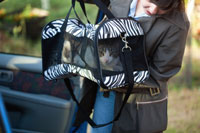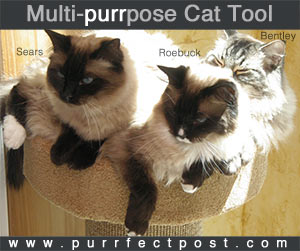Choosing a Cat Carrier
Many cats don't need to ride in a carrier very often, but you will find that you do need one from time to time. Below are some instances for which a cat will need a carrier:

- When you take your kitty in for her routine check-ups and vaccines.
- For occasional travel.
- For an overnight motel visit if your house is being renovated.
- To travel to the emergency clinic if something happens.
- If a calamity such as an earthquake, fire, or flood should strike your home.
Types of Available Cat Carriers
There are four main types of cat carriers:
- Homemade carrier from items you have at home. Some people transport their cats in an old cardboard box, a pillow case, or a laundry basket. These types of carriers are not safe for moving your cat around. Cats can easily escape or become injured if you are transporting them in items that are not specifically designed to be cat travel carriers.
-
Cardboard carrier. You will typically find this type of carrier at cat adoption facilities. They are often given to clients for transporting a newly-adopted cat home. While they are mostly acceptable for this limited, short-term use, cardboard boxes are not recommended as your regular, permanent carrier, for the following reasons.
- Cardboard is not strong enough to stand up to a cat's scratching. After several uses, you may find that Miss Kitty has opened up a few holes and is gearing up for a breakout.
- Cardboard is not good in the rain; it will become soft and spongy and can offer a quick escape.
- Cardboard is not good with urine, spilled water, or other liquids with which it may come into contact. These substances will weaken the cardboard, and it is not possible to adequately clean them off for future use. Cardboard carriers are also not approved for airline use.
-
Soft-sided carrier. These types of carriers are usually made of nylon or ballistic nylon, and they are lightweight and easy to tote. Some things to keep in mind about soft-sided cat carriers are:
- While sturdy and quite popular for pet travel, soft-sided carriers should only be used for cats that are good, calm travelers. It is possible for cats to tear out the nylon mesh ventilation panels if they become extremely agitated. There is also the potential for a very determined claw to get through the zipper material, leading to a torn nail or even an escape.
- If you use a soft-sided carrier, be sure that it is sized correctly for your cat. She must be able to stand up, turn around, and lie down easily—and have a meal and drink inside for longer trips—yet there shouldn't be so much space that she can slide around a great deal in air turbulence or a rough car ride.
-
Cats especially like small spaces, so try not to get a larger carrier than is necessary. The coziness of a small carrier makes feline passengers feel secure.
Soft-sided carriers are much easier to clean than cardboard carriers. It's a good idea to purchase a soft-sided carrier that does not sag a great deal when your pet is inside. Most have light frames to prevent this. If you are unsure about the sturdiness of a carrier's floor while you are making your purchase, simply put a heavy book or several items from the pet store aisle inside and check. A sagging bottom will be quite uncomfortable for your cat.
-
Hard-sided carrier. This type of carrier is usually made of plastic, and they are very sturdy and durable. Some of the pros and cons of hard-sided carriers are as follows:
- Plastic carriers are the easiest of the carrier types to clean.
- Hard-sided carriers may be a bit harder to fit under an airline seat, but if a heavy object should fall against it, it will afford much more protection to the occupant than a soft-sided carrier.
- The best hard carriers have a steel mesh door that is much sturdier than plastic mesh. The carrier's hardware should be metal.
-
Before you purchase the carrier, assure yourself that the handle is stout enough to support the weight of the carrier and its occupant without breaking.
Hard-sided carriers must also be sized for the occupant. As with the soft-sided carrier, adequate room for standing up, turning around, and lying down must be permitted. For longer travel, allow room for food, water, and, in some cases, a small box of kitty litter.
Additional Considerations When Choosing a Cat Carrier
Here are a few more things to keep in mind when choosing a new cat carrier:
- Adequate ventilation is a requirement for any pet carrier, with openings on three sides preferred.
- Each airline has different rules regarding the type of pet carriers permitted on their aircraft, so be sure to check with yours when you travel by plane.
- It is extremely helpful to have a cat carrier that opens from the top as well as in the front. Cats that are reluctant to get into or out of the carrier may be loaded and unloaded easier from the top than the front or side.
- Cat carriers are a safe, useful, and sometimes required, way to transport your cat. It is important that your cat rides in one well. Learn how to train your cat to use a carrier in "How Do I Get My Cat into a Carrier?"
You May Also Like These Articles:
Why Should I Take My Cat to the Vet?
How To Take Your Cat To The Vet
Bringing Home a New Cat: A Checklist
Training Your Cat To Use A Pet Carrier
Notice: Ask-a-Vet is an affiliated service for those who wish to speak with a veterinary professional about their pet's specific condition. Initially, a bot will ask questions to determine the general nature of your concern. Then, you will be transferred to a human. There is a charge for the service if you choose to connect to a veterinarian. Ask-a-Vet is not manned by the staff or owners of CatHealth.com, and the advice given should not delay or replace a visit to your veterinarian.





